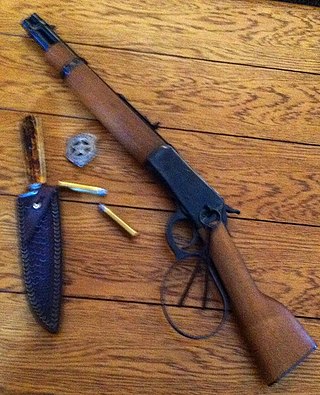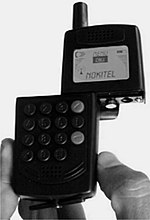
A carbine is a long gun that has a barrel shortened from its original length. Most modern carbines are rifles that are compact versions of a longer rifle or are rifles chambered for less powerful cartridges.

A firearm is any type of gun that uses an explosive charge and is designed to be readily carried and used by an individual. The term is legally defined further in different countries.

A muzzle brake or recoil compensator is a device connected to, or a feature integral to the construction of, the muzzle or barrel of a firearm or cannon that is intended to redirect a portion of propellant gases to counter recoil and unwanted muzzle rise. Barrels with an integral muzzle brake are often said to be ported.

The National Firearms Act (NFA), 73rd Congress, Sess. 2, ch. 757, 48 Stat. 1236 was enacted on June 26, 1934, and currently codified and amended as I.R.C. ch. 53. The law is an Act of Congress in the United States that, in general, imposes an excise tax on the manufacture and transfer of certain firearms and mandates the registration of those firearms. The NFA is also referred to as Title II of the federal firearms laws, with the Gun Control Act of 1968 ("GCA") as Title I.

The M203 is a single-shot 40 mm under-barrel grenade launcher designed to attach to a rifle. It uses the same rounds as the older stand-alone M79 break-action grenade launcher, which utilizes the high-low propulsion system to keep recoil forces low. Quite versatile and compatible with many rifle models, the M203 was originally designed for the U.S. M16 and its carbine variant, the M4. The launcher can also be mounted onto a C7, a Canadian version of the M16 rifle; however, this requires the prior removal of the bottom handguard.

A sawed-off shotgun is a type of shotgun with a shorter gun barrel—typically under 18 inches (46 cm)—and often a pistol grip instead of a longer shoulder stock. Despite the colloquial term, barrels do not, strictly speaking, have to be shortened with a saw. Barrels can be manufactured at shorter lengths as an alternative to traditional, longer barrels. This makes them easier to transport and conceal due to their smaller profile and lighter weight. The design also makes the weapon more portable when maneuvering in confined spaces and for that reason law enforcement and military personnel find it useful in close-quarters combat scenarios. As a result of the shorter barrel length, any shotgun with a tubular magazine will have a reduction in its magazine capacity.

An automatic firearm or fully automatic firearm is an autoloading firearm that continuously chambers and fires rounds when the trigger mechanism is actuated. The action of an automatic firearm is capable of harvesting the excess energy released from a previous discharge to feed a new ammunition round into the chamber, and then igniting the propellant and discharging the projectile by delivering a hammer or striker impact on the primer.
In the United States, a destructive device is a type of firearm or explosive device regulated by the National Firearms Act of 1934, revised by the Omnibus Crime Control and Safe Streets Act of 1968 and Gun Control Act of 1968.

A flare gun, also known as a Very pistol or signal pistol, is a large-bore handgun that discharges flares, blanks and smoke. The flare gun is typically used to produce a distress signal.
A Federal Firearms License (FFL) is a license in the United States that enables an individual or a company to engage in a business pertaining to the manufacture or importation of firearms and ammunition, or the interstate and intrastate sale of firearms. Holding an FFL to engage in certain such activities has been a legal requirement within the United States since the enactment of the Gun Control Act of 1968. The FFL is issued by the Bureau of Alcohol, Tobacco, Firearms, and Explosives

H&R 1871, LLC, or more commonly known as Harrington & Richardson, is an American brand of firearms and a subsidiary of JJE Capital Holdings. H&R ceased independent production February 27, 2015.

The Auto & Burglar Gun was a US-made factory-built handgun that was commercially manufactured by configuring a standard double-barrel shotgun with a pistol grip, at first engraving and later stamping "Auto & Burglar Gun" on each side of the frame, and shortening the barrels to about 10" to 12.2" in length. A holster with a flap and a snap was available for purchase from Ithaca. It was outsourced to a leather company and was embossed with "Auto & Burglar" on it. They are also very rare and are infrequently seen for sale in any condition.

Short-barreled rifle broadly refers to any rifle with an unusually short barrel. The term carbine describes a production rifle with a reduced barrel length for easier handling in confined spaces. Concern about concealment for illegal purposes has encouraged regulations specifying minimum barrel lengths and overall lengths.

An antique firearm is a term used to describe a firearm that was designed and manufactured prior to the beginning of the 20th century. Although the exact definition of what constitutes an "antique firearm" varies between countries, the advent of smokeless powder or the start of the Boer War are often used as cut-off dates. Antique firearms are usually collected because of their historical interest and/or their monetary value.

The Mare's Leg is the name given to a customized shortened rifle used by Steve McQueen's character on the television series Wanted: Dead or Alive (1958–1961). McQueen's character was named Josh Randall. Mare's Leg is now a generic term for a Winchester Model 1892 with a shortened barrel and stock.
The following are terms related to firearms and ammunition topics.
The Marble Game Getter is a light, double-barrel (over-under), combination gun manufactured by the Marble's Arms & Manufacturing Company in Gladstone, Michigan. The firearm features a skeleton folding stock and a rifle barrel over a smooth-bore shotgun barrel. A manually pivoted hammer striker is used to select the upper or lower barrel. Three generations of the system were/are produced—First Generation, Second Generation and the Third Generation currently manufactured by Marble Arms.

A silencer, also known as a sound suppressor, suppressor, or sound moderator, is a muzzle device that suppresses the blast created when a gun is discharged, thereby reducing the acoustic intensity of the muzzle report and jump, by modulating the speed and pressure of the propellant gas released from the muzzle. Like other muzzle devices, a silencer can be a detachable accessory mounted to the muzzle, or an integral part of the barrel.

The SIG MPX is a gas-operated submachine gun designed and manufactured by SIG Sauer, and is primarily chambered in 9×19mm Parabellum. It is a gas-operated firearm featuring a closed, rotating bolt. These design features, rare in submachine guns, were chosen to enhance the safety of the user and to have a more reliable firearm. It was designed in 2013 and was released to the general public in 2015. It features the SIG Sauer short stroke push-rod gas system to reduce the recoil and improve the reliability of the weapon.

A gun serial number is a unique identifier assigned to a singular firearm.



















